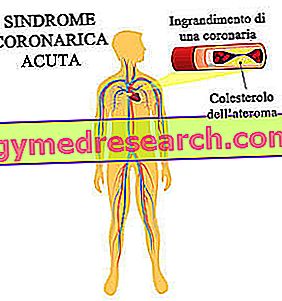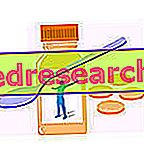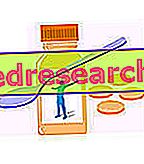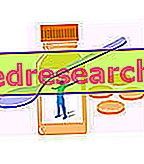Generality
Acute coronary syndrome is the set of symptoms and signs that occurs due to a narrower or more severe narrowing of the coronary arteries. In most cases, at the origin of this narrowing, there is atherosclerosis.

Usually, the first diagnostic investigations consist of an electrocardiogram and blood tests; if time permits, further checks are carried out.
The invasiveness of the treatment (only pharmacological or even cardiac surgery) depends on the extent of the narrowing and the severity of the symptoms.
What is acute coronary syndrome?
Acute coronary syndrome is the term by which doctors indicate any cardiac distress due to a narrowing of the coronary arteries .
The coronary arteries, or more simply coronary arteries, are the blood vessels that conduct oxygenated blood to the myocardium, ie the muscle tissue of the heart. Their severe occlusion can strongly reduce the blood supply in a given area of the heart ( ischemia ) and, in the most serious cases, induce the death of the affected tissue ( infarct ).
ACUTE CORONARY SYNDROME, HEART ATTACK AND UNSTABLE ANGINA
Acute coronary syndrome may be the result of a heart attack or an unstable angina episode. To establish its exact nature is only an accurate diagnostic investigation.
- The heart attack (or myocardial infarction ) is a very serious condition, characterized by a closure of the coronaries so important that part of the myocardium undergoes necrosis (ie it dies).
The death of cardiac muscle tissue is final (NB: it is replaced by scar tissue) and involves a stable reduction in cardiac function. A heart that does not work as it should affect the blood circulation to the various districts of the body.
From the clinical point of view, the acute coronary syndrome can present itself as a myocardial infarction following a total occlusion of a coronary vessel or as a myocardial infarction following a partial occlusion of the coronaries.
- Unstable angina is a pathological condition less severe than a heart attack, but still linked in some way to a narrowing at the level of the coronaries.
In unstable angina, the occlusion is not such as to cause myocardial death; however, in the absence of adequate care, the process of necrosis could occur within a short time.
The term unstable indicates that angina appears suddenly and also at rest (NB: stable angina, on the other hand, arises less suddenly and never at rest, only under stress).
Epidemiology
Acute coronary syndrome is a fairly common condition.
For example, in the UK, it appears to be responsible for around 114, 000 hospital admissions a year.
The people most affected are those over 50, although it should be specified that the aforementioned heart disease can also occur in young adults.
The most interested sex is the male one.
Causes
The main cause of acute coronary syndrome and coronary occlusion that distinguishes it is atherosclerosis .
Atherosclerosis is a degenerative disease of medium and large caliber arteries, which favors the deposit of fat and other substances on the internal vessel wall.

Figure: Atherosclerosis is the main cause of acute coronary syndrome. Among the factors that favor atherosclerosis, there is an incorrect diet containing many fats.
This deposit - called atheroma or atherosclerotic plaque - obstructs blood flow and, if it breaks down, gives rise to an inflammatory reaction that results in an increase in its size and a worsening of the previous picture.
Atherosclerosis, therefore, is a progressive morbid condition, which could remain silent for years, only to cause serious consequences.
OTHER CAUSES
The process of occlusion of the coronary arteries, which then induces acute coronary syndrome, can arise for reasons other than atherosclerosis.
In fact, it can be just as decisive:
- The presence of inflammation at the level of the coronary arteries ( coronary vasculitis ). This is a rare phenomenon.
- An episode of coronary embolism, following the disintegration of a blood clot formed in a different vessel from the coronary arteries. In other words, from a thrombus located in a blood vessel or in a cardiac cavity, a part of it can detach and be transported from the blood to the coronaries.
- Cocaine intake .
- Having undergone cardiac surgery . Heart surgery presents a reasonable risk margin and acute coronary syndrome is one of the possible dangers of this practice.
- The presence of some rare heart diseases .
Factors that induce atherosclerosis:
- Old age
- Male sex
- Genetic predisposition to the disorder
- Cigarette smoke
- Hypercholesterolemia
- Hypertension
- Obesity
- sedentary
- Diabetes mellitus
Sometimes, atherosclerosis and the aforementioned causes act in concert.
RISK FACTORS
The risk factors for acute coronary syndrome, that is, all those situations that predispose to the onset of the aforementioned heart disorder, are the same as those for myocardial infarction and cardiovascular diseases in general.
They can be divided into two categories: non-modifiable favoring factors and modifiable favoring factors .
Among the non-modifiable, remember:
- Advanced age
- The male sex
- Familial predisposition to heart diseases
- Belonging to ethnic groups particularly predisposed to cardiovascular disorders, such as the Caribbean race or the African American breed.
Among the modifiable factors, instead, they deserve a mention:
- hypertension
- obesity
- hypercholesterolemia
- A sedentary lifestyle
- An incorrect diet
- Diabetes mellitus
Symptoms and Complications
The typical symptoms and signs of acute coronary syndrome are, of course, the same as those that characterize the heart attack and unstable angina, therefore: chest pain, sense of fainting, sweating, dyspnea (even to rest), nausea and vomiting .
BREAST PAIN

Figure: chest pain is the most characteristic symptom of acute coronary syndrome
The pain in the chest is the disorder most probably warned and with which many medical treatises identify acute coronary syndrome.
Patients describe it as a sense of pressure in the chest, which sometimes also radiates towards the jaw and left arm. This particular distribution of pain is due to a crossing of several sensitive nerve pathways.
OTHER SYMPTOMS
Sometimes, the symptom picture can be completed with the appearance of:
- Abdominal pain
- Stomach ache
- Cyanosis
- Syncope
- Strong sense of fatigue
- Sense of anxiety and restlessness
WHEN TO REFER TO THE DOCTOR?
It is good to contact your doctor or go to the hospital if you should feel the symptoms mentioned above. Particularly, attention must be paid to chest pain associated with dyspnea at rest.
The timeliness of the rescue and the immediate start of treatment are fundamental in order to avoid the worst, including the death of the patient due to a heart attack.
Diagnosis
When an individual comes to the hospital with all the typical symptoms of a heart attack or unstable angina, doctors immediately submit him to an electrocardiogram (ECG).
By recording the electrical activity of the heart, the electrocardiogram makes it possible to determine whether the heart is beating normally or not.
During acute coronary syndrome, the heart rhythm (thus the electrical activity of the heart) is altered in an easily recognizable manner.
ATTACK OF HEART OR INSTABLE ANGINA?
To quickly understand if the nature of acute coronary syndrome is linked to a heart attack or unstable angina, doctors take a blood sample from the patient .
If the analysis of this sample shows a strong presence of certain enzymes ( troponins, CK-MB etc.), it could mean that a heart attack is in progress. Vice versa, if from the blood analysis the presence of the same enzymes is scarce or null, it could mean that an unstable angina is in progress.
All this is explained by the fact that, when there is a profound damage to the myocardium, the latter releases the aforementioned enzymes into the blood.
OTHER DIAGNOSTIC PROCEDURES
When the situation is under control, for the purpose of deepening, the doctors submit the patient to further examinations and diagnostic tests.
In particular, they resort to:
- An echocardiogram
- A chest X-ray
- An angio-CT scan
- Coronary angiography
- A stress test
Treatment
The therapy adopted in the presence of acute coronary syndrome depends on two factors: the severity of the coronary narrowing (hence the severity of the causes) and the severity of the symptomatic picture .
For less severe cases, a drug- based treatment may be sufficient; for the most severe cases, on the other hand, it becomes essential to resort to cardiac surgery .
PHARMACOLOGICAL THERAPY
The medicines usually used are:- Aspirin and other blood thinners (anticoagulants)
- thrombolysis
- Nitroglycerin
- Beta blockers
- ACE inhibitors and angiotensin receptor antagonists
- Calcium channel blockers
- cholesterol-lowering
CARDIOSURGICAL THERAPY
Cardiac surgery is reserved for cases that present a severe coronary occlusion, which must be released at all costs if the patient is to be saved.
The most important and practiced procedures are:
- Angioplasty followed by stenting . During this operation, the cardiac surgeon re-establishes the original patency of the occluded coronary artery, modeling the artery lumen also thanks to the insertion of a hollow metal cylinder ( stent ).
- Coronary bypass . Through this procedure, the cardiac surgeon creates an alternative route to the passage of blood by inserting a new coronary vessel.

OTHER IMPORTANT MEASURES AND REMEDIES
In addition to the treatments just described, anyone who is a victim of acute coronary syndrome (or another heart disease) should:
- Stop smoking (if you are a smoker)
- Adopt a healthy diet under all circumstances
- Keep active (compatibly with the health of your heart)
- Periodically check your cholesterol levels and keep them within normal values
- Periodically check your blood pressure and keep it at normal levels
- Lose weight (if you are obese or overweight)
- Learn to control the stress of everyday life
- Don't drink alcohol
- Continue to take medications prescribed by your doctor, necessary to reduce the risk of a relapse. The medicines in question are generally aspirin, beta-blockers, ACE inhibitors and cholesterol-lowering agents.
Prognosis
A partial occlusion of the coronary arteries and / or an appropriate and timely cure positively influence the chances of recovery. Conversely, a severe narrowing of the coronary arteries and / or delayed or inadequate therapy increase the likelihood of complications.
Therefore, the prognosis of acute coronary syndrome depends on the severity of the triggering causes and the timeliness of the treatments.



